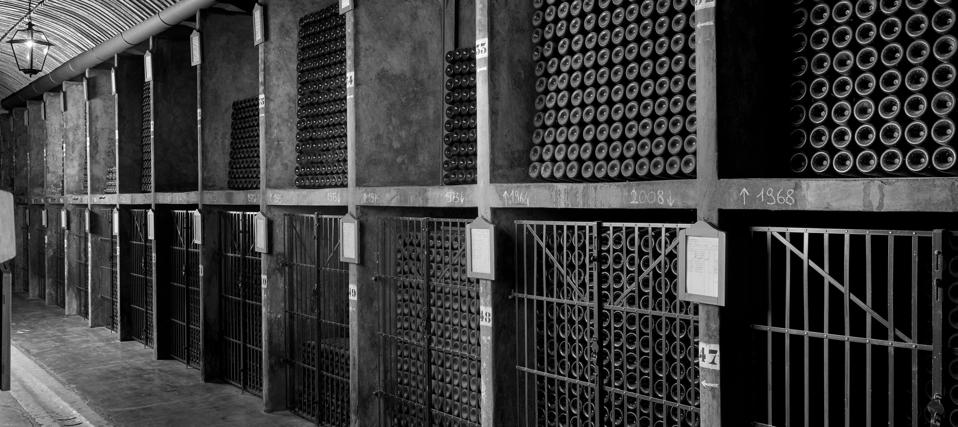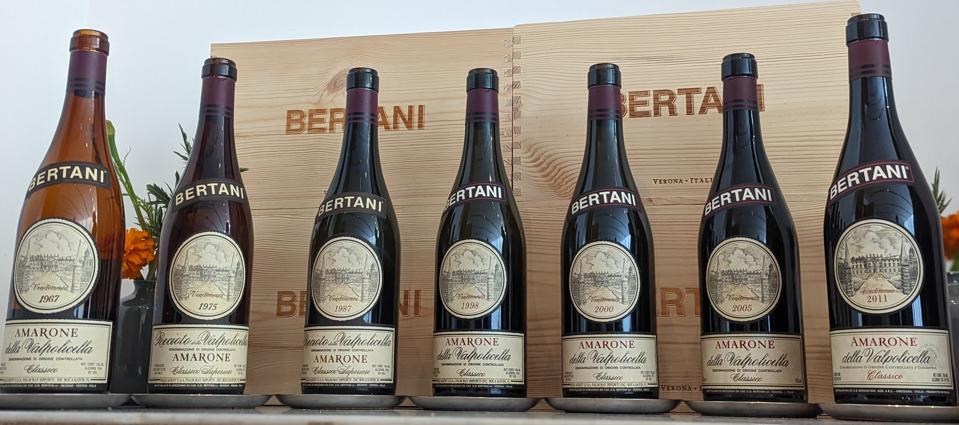Library of Bertani Amarone della Valpolicella Classico wines
The antique lights, with their long necks connected to the otherworldly vaulted ceilings, gave a soft, warm glow to the never-ending wine barrels lining the stone walls. All those Slavonian oak casks filled with delicious wines emitted the most intoxicating smells and gave a thrill to those in their presence. Yet the most awe-inspiring experience was further down the corridors of the cellar, where numerous cubicles with iron gates kept some of the most precious items locked away. The Amarone wines of Bertani were tucked away in those cellars, and by the mid-1980s, over two million bottles of Amarone della Valpolicella Classico were kept safely within the Cantine Bertani wine cellars located in Valpolicella, Italy.
And despite Amarone not finding a market until the 1980s, family owner Guglielmo Bertani kept making these elegantly complex Amarone wines for decades, and so, he cellared them away until, over time, two million bottles were collected.
Amarone della Valpolicella Classico
Barrels in the Bertani cellar
The historic wine producer Bertani might have been established in the 1850s by the Bertani brothers but their legend began when Amarone was born in the 1950s. During the ’50s, the great wine of Valpolicella was the sweet red wine called Recioto della Valpolicella as it was a wine made from grapes that were harvested and left on straw mats to dry for some time; due to the drying process, a significant amount of water would evaporate leaving the grapes more concentrated with flavors and sugars. During the fermentation process, once a certain alcohol level was reached, the fermentation was arrested, leaving enough residual sugar to make it a sweet wine. But in the 1950s, a few producers had some of their Recioto fermentations go too long, to the point where all the sugars had fermented into alcohol and the Amarone dry wine was born.
In 1958, when Guglielmo Bertani was first faced with the magic elixir that would become known as Amarone in his barrels that usually made Recioto, he was highly intrigued by this succulent, multifaceted wine. Since he knew very little about making a serious dry red wine, he sought the help of a winemaker from the Piedmont region of Italy, famous for the iconic Barolo wines. The winemaker knew nothing about Amarone or the soils and native grape varieties of Valpolicella but the more he tasted those Amarone barrels, the more he fell in love with the wines. He ended up partnering with Guglielmo as the winemaker for Bertani. They would unite to make Amarone wines on the same level as the best Barolos, based on expressing the terroir of the best plots in Valpolicella. Guglielmo continued his promise to devote himself to making Amarone, whether it sold or not.
Today, the director of winemaking of Bertani, Andrea Lonardi, gives an idea of the market demands back in the 1980s and before, as he said, when it came to the total sales of Recioto and Amarone before the ’80s, it was broken down into 98% Recioto and 2% Amarone, then ten years later it was 50/50, but today it is 99% Amarone and 1% Recioto.
Bertani
Andrea Lonardi holding up white limestone and red limestone from Bertani’s vineyards
A few factors make Bertani unique within the realm of Amarone producers in Valpolicella. The first is their soils – despite having a combination of limestone and red limestone which is typical in top vineyards, they also have the most amount of volcanic soils as Andrea Lonardi noted that Bertani owns almost 70% of the vineyards with volcanic soils in the designated Valpolicella area; giving a distinctive “iron” note to their wines as they age. The second is their drying process, typically called “appassimento” by other Amarone producers, yet they use the “messa a riposo” rules, which translates into “laying out to rest.” Today, many Amarone producers use rooms where the drying process takes place, controlling the temperature and humidity. Instead, Bertani places the grapes on a single layer of bamboo racks to dry in natural conditions, selecting 30% of their top selection of the harvest.
The drying process “messa a riposo” at Bertani
For Bertani, the drying process isn’t just a method, it is part of the expression of the terroir within a particular time frame. That time frame doesn’t only end with harvesting the grapes but it ends once the drying process has finished and so the vintage is an expression of what happens during the growing season and the drying process. Also, another layer to the theory of the drying process being part of the expression of place are the research studies conducted in Valpolicella that show the main grape variety used for Amarone, Corvina, will go through genetic alterations, that heighten the terroir expression, during the drying process that has been linked to specific plots within the Valpolicella wine area.
And the third factor is that Bertani releases their Amarone wines seven to eight years later than most Amarone producers, as their 2012 was just released. The wines age in Slavonian oak casks until they are released and Andrea estimates that they lose an equivalent of 25,000 bottles of wine due to the wine evaporating in the barrel. “And so, it means in ten years, we are losing 250,000 bottles,” exclaimed Andrea, and he further described the multilayered complexity created by the wines evolving in barrel for several years but also the addition of young Amarone wine, as topping up the barrels is necessary and so the last two vintages are used; the fresh fruit combined with the aged aromas and flavors make Bertani Amarone a “light and succulent wine.”
Andrea Lonardi leading a vertical tasting of Bertani Amarone della Valpolicella Classico in New York … [+]
After leading a vertical of Bertani Amarone wines at The Modern restaurant in New York City recently, Andrea marveled at the 1967, how it was like an “Italian sword” with that iron quality evident in the wine with an oxidative evolution while still having a lot of tension that was fierce in its delivery on the palate. He noted that it was like a great old Barolo as he made the point, “This is what we want to drink when we say we want to drink an Italian wine!” And he is thankful to work for an iconic winery with an extensive Amarone library that includes 45 vintages. Although they no longer have two million bottles, Andrea is sure they have at least over 100,000 bottles in the cellar but they haven’t done an official count. And they are still committed to cellaring around 7,000 to 10,000 bottles of every vintage to ensure their customers will always have access to several decade-old bottles.
And that commitment started all those years ago with Guglielmo Bertani continuing his passion of making Amarone and cellaring it, hence tying up tons of capital waiting for the market to possibly gain interest in it, which wasn’t for decades. “There will be a moment when the market will change and this is the most beautiful present that I can give to my nephews,” Guglielmo said in response to those who thought he had gone mad. And thank goodness he wasn’t afraid to follow his passion, as many might have never experienced the true “Italian sword” that a great Amarone becomes in time.
Bertani Amarone della Valpolicella Classico vertical
Bertani, Amarone della Valpolicella Classico, vertical:
1967: High-toned red fruit with zingy cranberry, saline minerality, a bolt of iron with dried red cherries on the palate with intense energy and marked acidity with an overall lightness of being.
1975: Crushed rocks, lit incense sticks and rosebud aromatics that expand in the mouth with savory flavors of dried oregano and truffles with lots of volume on the body.
1987: Vibrant right off the bat with a complex mixture of tar and crushed black cherries with a slight grip on the tannins balanced by good flesh on the mid-palate with a long, expressive finish with fresh flowers and baking spices.
1998: Pristine blackberry fruit, cocoa nibs and star anise with a broad palate and fully integrated tannins with juicy black fruit on the finish.
2000: Enchanting floral nose with pretty notes of cinnamon and nutmeg with a mineral backbone giving notes of broken limestone with round tannins.
2005: A perfumed nose with charming red fruit and crumbly chalk aromas with a touch of smoky minerality with black tea leaves and a linear body with lots of drive on the long, expressive finish.
2011: Sweet tobacco leaf and dried smoked cherries with blackcurrant strudel and fresh leather with lots of structure, freshness and ample tannins that will give this wine a ridiculously long life.
2012: The purity of fruit is stunning with red raspberries and wild mulberries with pretty violet and pressed rose petal notes and a saline minerality in the background with finely etched tannins. Extremely elegant.






